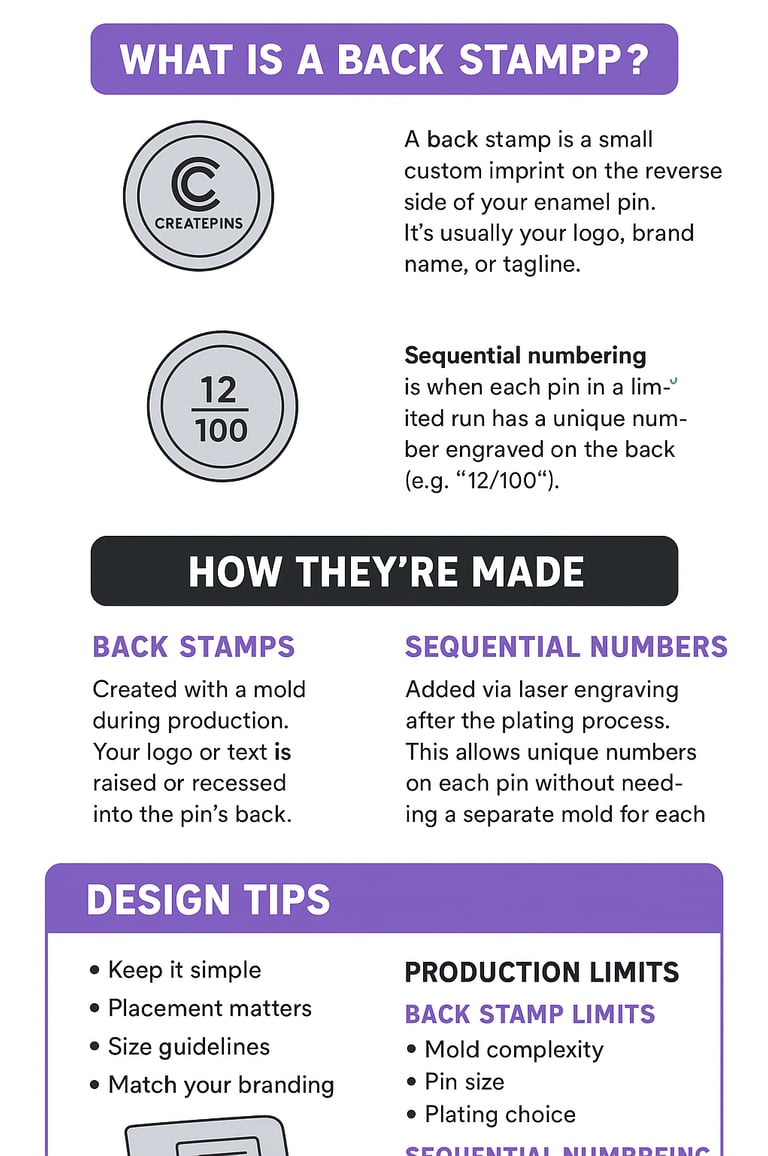Custom Back Stamps for Limited Edition Pins
Discover the significance of back stamps on enamel pins, including custom imprints and limited edition pins. Learn how these features enhance the value of limited edition and collector's pins, making each piece unique.
CreatePins
2/7/20243 min read


Enamel pins aren't just wearable art — they're also collectibles. One way to increase their value, exclusivity, and brand recognition is by adding sequential numbering and a back stamp to your pin designs.
These small details make a big difference. Sequential numbering appeals to collectors by emphasizing rarity, while a custom back stamp helps solidify your brand identity.
In this guide, we'll explain how each option works, design tips, and the production limits you need to keep in mind.
✨ What Is a Back Stamp?
A back stamp is a small, custom imprint on the reverse side of your enamel pin. It's usually your logo, brand name, or tagline, and serves as a permanent signature.
Benefits of Back Stamps:
Establishes brand identity and professionalism
Protects your design from copycats (marks authenticity)
Adds collectability for fans who recognize your logo
Works on nearly any pin size and style
🔢 What Is Sequential Numbering?
Sequential numbering is when each pin in a limited run has a unique number engraved on the back (e.g., "12/100"). This method is especially popular for limited edition or collector's pins.
Benefits of Sequential Numbering:
Creates exclusivity and scarcity
Adds long-term collectible value
Makes each pin feel unique and special
Encourages faster sell-outs for limited runs
🛠️ How Back Stamps & Sequential Numbers Are Made
Back Stamps: Created with a mold during production. Your logo or text is raised or recessed into the pin's back.
Sequential Numbers: Added via laser engraving after the plating process. This allows unique numbers on each pin without needing a separate mold for each.
🎨 Design Tips
Keep It Simple
Back stamp logos should be clear and minimal. Tiny details may not show up well.
Bold lines and simple text are ideal.
Placement Matters
Place back stamps in the center or bottom area of the pin back.
Sequential numbering is usually placed just below the back stamp.
Size Guidelines
Back stamps work best at 0.5–1 inch wide depending on pin size.
Numbering is usually very small, so avoid overly decorative fonts.
Match Your Branding
Use your brand's logo, website, or initials for the back stamp.
Limited runs? Add “LE 100” or similar text.
⚠️ Production Limits
Before adding back stamps or numbering, consider these limits:
Back Stamp Limits
Mold Complexity: Very fine or small text may not reproduce well in the mold.
Pin Size: On pins smaller than 1 inch, space for a back stamp is very limited.
Plating Choice: Highly textured antique platings may make small logos harder to see.
Sequential Numbering Limits
Placement Space: Requires a flat area on the back of the pin for engraving.
Size: Numbers must remain small to fit; avoid long edition sizes (like 1/10,000).
Production Time: Laser engraving adds extra time after plating, which can extend turnaround.
Durability: Numbers can fade slightly over decades if exposed to heavy wear, but usually remain legible.
💡 Creative Uses
Add your website URL or social media handle to the back stamp.
Use numbering for Kickstarter exclusives or limited-edition drops.
Combine both: Logo stamp + numbering for authenticity and rarity.
Create “chase variants” — a small subset of pins with unique numbering or alternate back stamp to encourage collecting.
✅ When to Use (and When Not To)
Best for:
Limited edition runs
Collector-focused designs
Branding and authenticity protection
Avoid for:
Extremely small pins (space constraints)
Very large editions (numbering may not feel special if it's 1/10,000+)
Pins where production speed matters most (engraving adds extra steps)
🔑 Final Thoughts
Adding back stamps and sequential numbering is a smart way to elevate your enamel pins. These features add branding, authenticity, and collectible appeal — making your pins more desirable for fans and collectors alike.
While there are production limits (like space and complexity), most designs can incorporate at least one of these options without issue. If you're serious about growing your pin brand, back stamps and numbering are details worth including in your next release.
Still don't know how? Consult our professional team by hello@createpins.com.
Custom enamel pins for artists and brands.
Contact
Copyright © 2025 Createpins.com owned by Raoin. All rights reserved.
Shipping Worldwide
Trusted by Thousands of Creators
Our Policy
